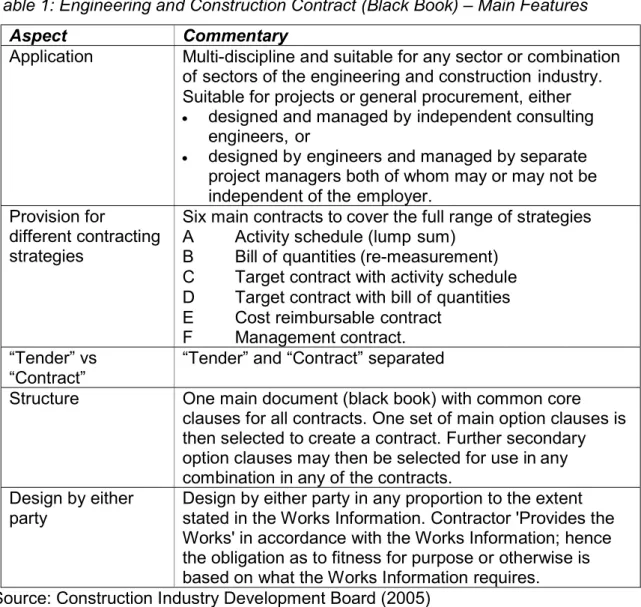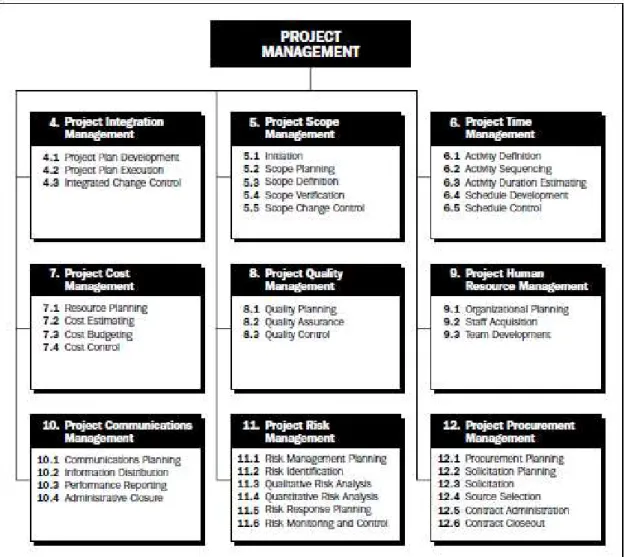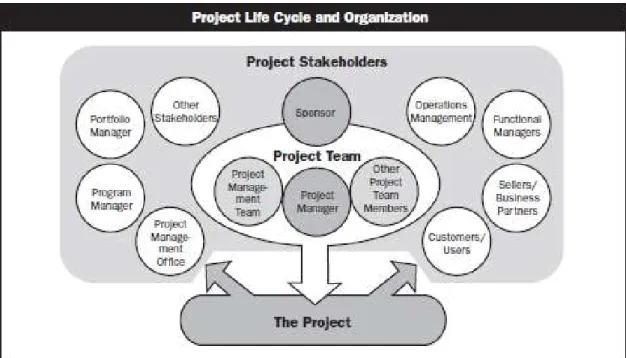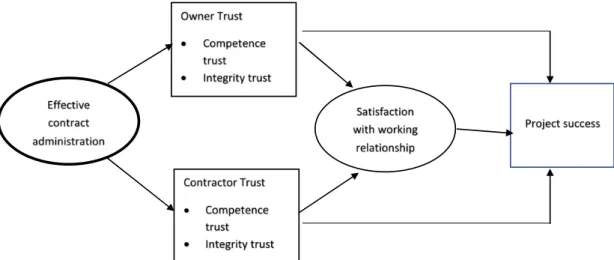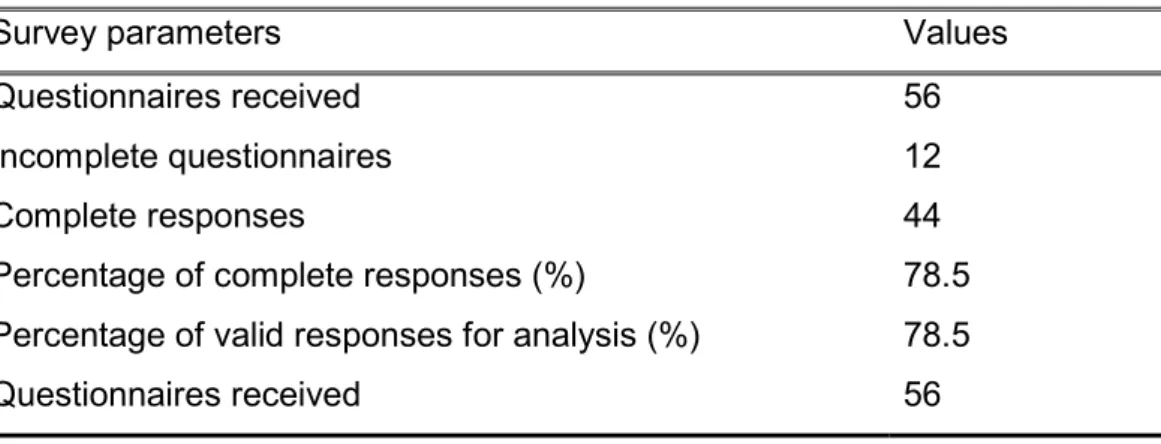Project management can be defined as the process of controlling the achievement of the project objectives (Munns & Bjeirmi, 1996). Within the project management function, the administration of the contract between the parties plays a key role in determining the outcome and success of the project.
Fundamentals of the NEC3 Contracts
The contract is designed in a way that inspires teamwork and collaboration between parties to resolve issues that have emerged during the project lifecycle. The design and administration of the contract easily provide a platform to build trust and fairness over the life of the project, but this depends on how effective the administration is and whether both parties are committed to the success of the project over the course of the project. life cycle.
Project Management Body of Knowledge (PMBOK)
Key Project Stakeholders
Contract Administration
Contract management within project management is critical for both parties as understanding, utilization and participation roles for both the employer and the contractor are defined in the contract. Relationships and trust, both within and between organizations, play a key role in the success of project management.
Project Management Success (Project Efficiency) and Project Success
The project management approach used is also influential on the success of the project as determined by Rolstadås et al. On the other hand, one of the nine groupings mentioned by Emsley and Alzahrami (2013) was management and technology.
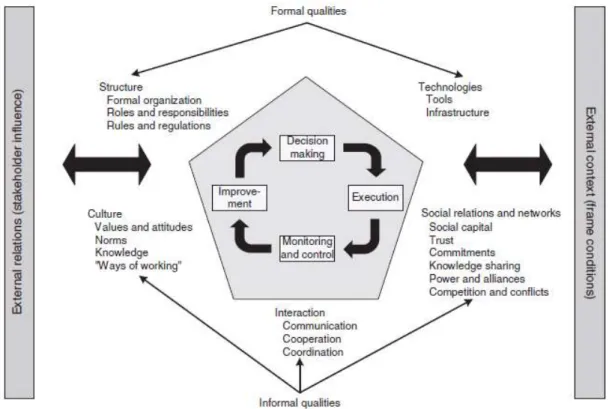
Trust in Projects
More than half of the respondents indicated that they had one or more projects that were not successful in the past year. A total of 82% of survey respondents expected greater collaboration between the owner and contractor in the next five years.
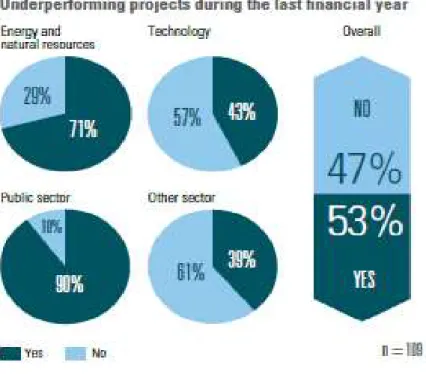
Relationship Management and Satisfaction in Projects
In addition, McCord and Gunderson (2014) in their study on factors that influenced the relationship between general and subcontractors touched on a key issue which was the role of the project manager. They claimed that the people management and administrative skills of the project manager had a direct effect on project success (Ahmed, Azmi, Masood, Tahir, & Ahmad, 2013; Rezvani, et al., 2016; McCord & Gunderson, 2014).
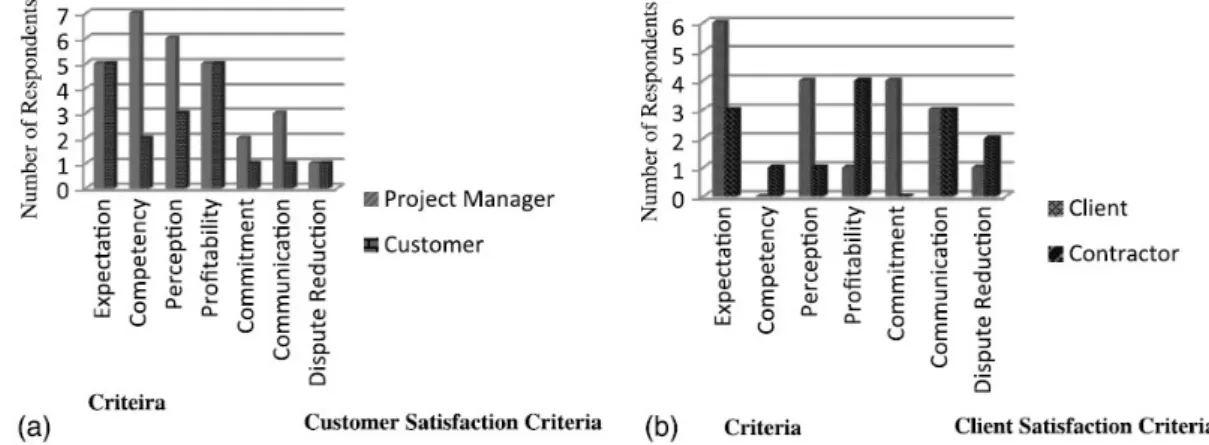
Contract Management and Administration
They investigated cognition-based trust as a mediator of the contract control-finish-based trust relationship and the propensity to trust in architect-contractor-project-based firms in China. The null hypothesis (H0) – The level of participation in an NEC3 contract is greater in public sector projects than in the private sector. The Alternative Hypothesis (H1) – The level of participation in an NEC3 contract is less in public sector projects than in the private sector.
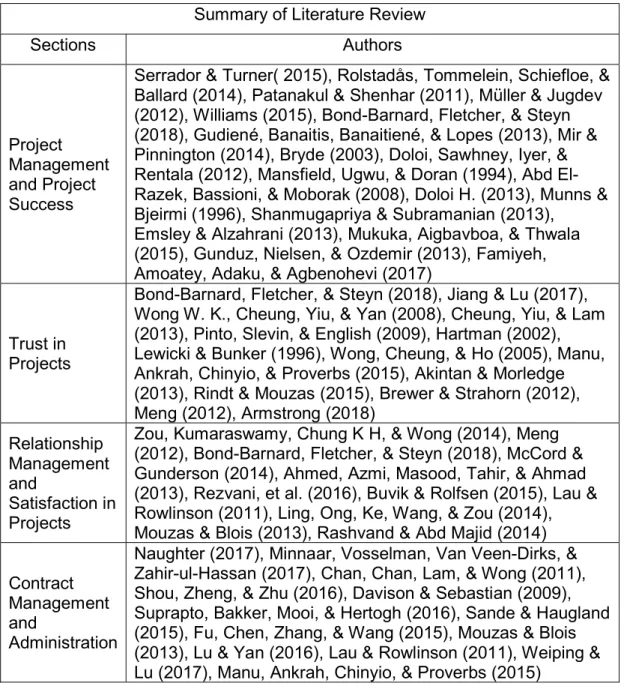
Philosophy
Approach
Methodological Choices
Purpose of Research Design
Strategy
Time Horizon
Techniques and Procedures
The respondents will be selected using the convenience sampling method, as the researcher has considerable knowledge of the industry, both private and public, and various companies. No connection between the respondents and their companies can and will be made as the name of the organization is not required as part of the questionnaire. If any of the questions conflict with a respondent's duty of confidentiality, they will be informed not to participate in the study in the consent letter.
Population
After that, the snowball method of sampling from the initial selection will be used, as the researcher will request that the survey be passed on to colleagues in different companies and industries.
Unit of Analysis
Sampling Method and Size
Pilot phase
Survey phase
Any survey feedback not related to the NEC3 contract will be discarded.
Measurement Instrument
To ensure the validity of the measuring instrument, the survey questionnaire will be sent to a small group of respondents. In addition, the researcher intends to look for other relevant evidence that supports the answers in the survey questionnaire. The reliability of the data will be measured by asking some of the respondents to answer the survey questionnaire twice.
Data Gathering Process
Reference to the clause will be made in the survey questionnaire and given that the researcher is targeting a population that has experience with the NEC3 contract, albeit as a list price contract, a target price list contract or a fixed cost contract. reimbursable (Barnes et. al., 2013b; Chan et al., 2011). If necessary, the sample size during the pilot survey will be increased to improve the reliability factor. A specified duration for responses will be explained in detail along with the reason for the survey questionnaire.
Analysis Approach
Papers and data will be peer-reviewed to ensure legitimacy, no older than five years to ensure information is up-to-date and will be from reliable sources based on ABS Journal Rankings, Google Scholar and sites of the Internet such as Emerald and Elsevier.
Summary of Survey Data
Industry/Sector Breakdown – Completed Questionnaires Only
This indicated that the working knowledge of both projects and the management of the NEC3 family of contracts was adequate.

Description of the Variables
V13 I feel comfortable being dependent on the other party throughout the life of the project. V16 I believe that the other party will adhere to high ethical principles throughout the life of the project. V30 I can rely on the other party not to complicate the project with careless work.
NEC3 (Factor 1) Summary of all Survey Responses
V41 The project that has been developed works as intended (or, if still under development, looks like it would work). V42 Given the problem for which it was developed, this project seems to do the best job of solving that problem – it was the best choice among the set of alternatives.
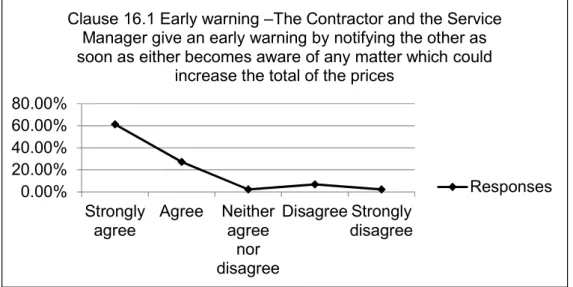
Exploratory Factor Analysis (EFA)
Trust factor analysis
Q24 My "gut feeling" tells me to be careful when dealing with the other party on a project. Q25 The other party would not knowingly hurt me to benefit themselves during the life of the project. Q27 Most people, even those who are not close friends of the other party, would trust and respect them if they were to carry out a project with them.
Satisfaction with working relationship factor analysis
Project success factor analysis
Q42 Given the problem it was developed for, this project seems to do the best job of solving that problem - it was the best choice among the set of.
Reliability Analysis
Satisfaction with the work relationship was measured on a 7-item scale and the Cronbach's alpha result was 0.927. Although the Cronbach alpha results for Factors 2 to 4 are high and approaching 1, the researcher is comfortable that minimal redundancy occurred with respect to the survey questions. The inter-item correlation for Factors 3 and 4 is higher than 0.5 which may suggest that the items are closely related, but not repetitive.
Summary of Survey Data for Comparison between Public and Private Sectors
The trust factor was measured on an 18-item scale, and the test for internal reliability using Cronbach's alpha was 0.913.
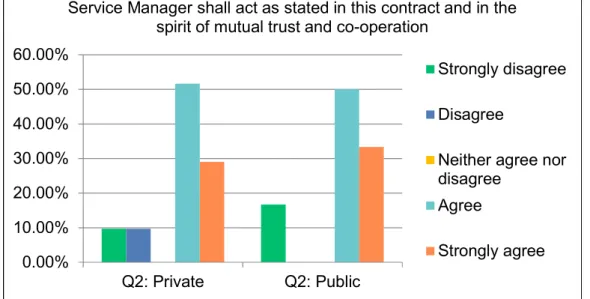
Correlation Analysis
- Summary of correlation analysis – SPSS data
- Graphical representation of Trust with Working Relationship factor –
- Graphical representation of Trust with Success factors – SPSS data
- Graphical representation of Working Relationship and Success factors –
A strong linear positive relationship between the trust factor and satisfaction with the work relationship factor, where p < 0.001.
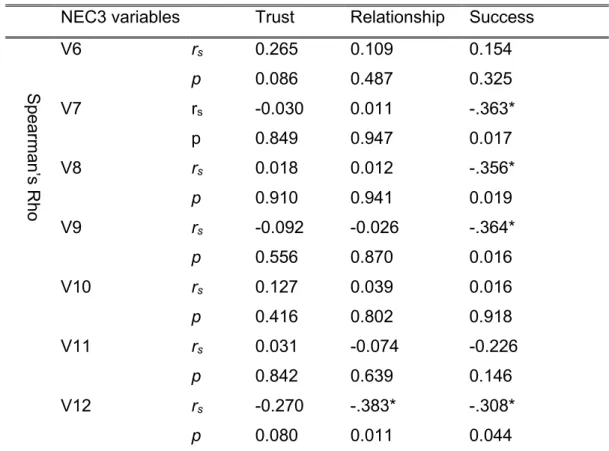
Comparison Between Sectors – SPSS Data
The tests were two-tailed with N = 31 for the private sector and N = 11 for the public sector. The combination of statistical and analytical data was used to obtain the results for the analysis and discussion.
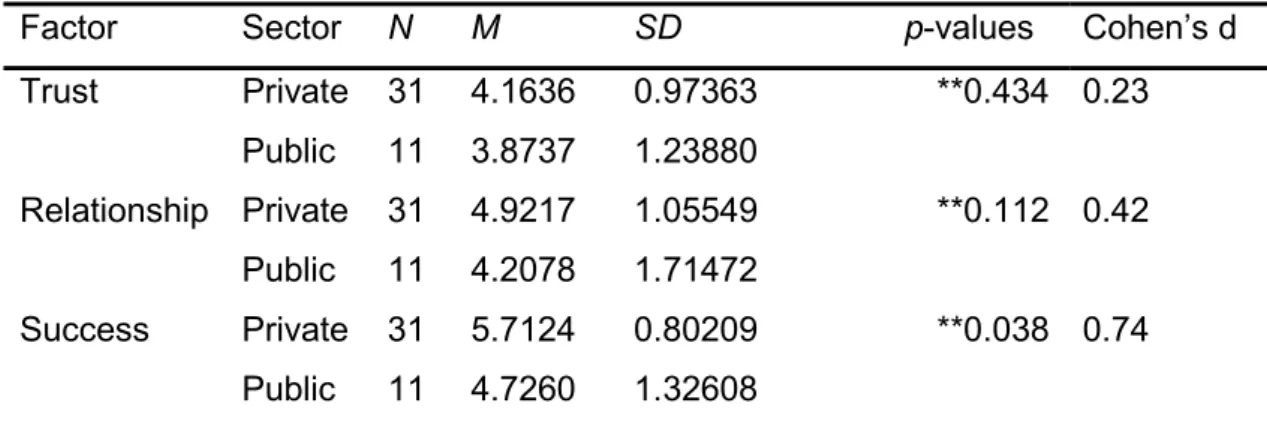
Hypothesis Question 1 Discussion – Does the Level of Participation in an NEC3
- NEC3 survey responses
- NEC3 survey responses and Factor 2 (trust) analysis
- NEC3 survey responses and Factor 3 (satisfaction with working
- NEC3 survey responses and Factor 4 (project success) analysis
- Factor 2 to 4 correlation analysis
An EFA was conducted to determine the adequacy of item correlations among the trust factor variables (Variables 13–30). The strength of the relationship between Factor 1 variables and Factor 3 variables (Variables 31–37) was determined by a correlation analysis. The strength of the relationship between Factor 1 variables and Factor 4 variables (Variables 38–46) was determined by a correlation analysis.
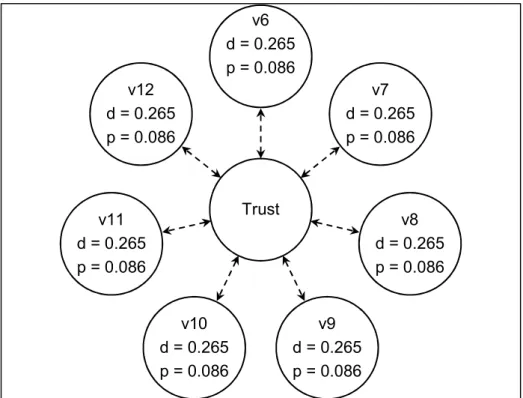
Hypothesis Question 2 Discussion – Is the Level of Participation Greater in the
NEC3 survey responses
The reference scale used for M and Mdn for this variable, closer to 1 means most respondents agree and closer to 4 means they disagree. The reference scale used for M and Mdn for this variable, closer to 1 means most respondents agree and closer to 5 means they disagree. The reference scale used for M and Mdn for this variable, closer to 1 means most respondents agree and closer to 3 means they disagree.
Private and public sector t-test analysis
The mean of the measure of central tendency, using the mean, is about the same with the private sector scoring slightly lower at 2.153% than the public sector at 2.1933%. On the other hand, the higher positive response rate of the public sector indicates that the contractor (private sector) is more willing to help mitigate risk and solve problems. Second, given the large cost of public projects in South Africa, the aim was to measure whether the use of contract is more evident in the public or private sector.
Principal Findings
While other contracts are still used, the aim of this study was to determine how effective management of this type of contract affects trust and project success. The use of KPIs to measure project performance can significantly influence PM success (Mir & Pinnington, 2014), and these can/are also used as contractual incentives. This clearly demonstrated that trust, job satisfaction and project success were strongly related without the inclusion of factor 1 variables (NEC3 contract).
Implication for Management and Other Stakeholders
Project efficiency is defined as the project meeting the time, cost and quality aspects while project success is measured by meeting stakeholder requirements in terms of strategic goals and return on investment (Rolstadås et al., 2014; Serrador & Turner, 2015; Patanakul & Shenhar, 2011). Moreover, in the current South African climate, the propensity for trust becomes an important aspect to avoid exploitation by both sides. The relational behavior of contractors is activated by the client upon initiation, resulting in the development of two-way relationships. 2005) state that if the client uses and correctly trusts controls, project performance can be increased by this harmonious relationship.
Limitations of the Research
The decision to invest in relational behavior is driven by a balance between the relational benefit and the cost of the effort. The respondent selection is not wide enough to include most of the major projects that used the NEC3 contracts done in the country. The fifth limitation of the research was that the focus was on individuals in project management or similar roles who use the NEC3 contract or have used it in the past.
Suggestions for Future Research
V7 Article 16.1 Early Warning – The Contractor and the Service Manager provide an early warning by notifying the other as soon as either becomes aware of a matter that could increase the total of the prizes. V8 Clause 16.1 Early Warning – The Contractor and the Service Manager provide an early warning by notifying the other as soon as either becomes aware of a matter that could disrupt the timing of the service. V9 Article 16.1 Early Warning – The Contractor and the Service Manager provide an early warning by notifying the other as soon as either becomes aware of a matter that could impair the effectiveness of the service.
COPY OF SURVEY QUESTIONS
